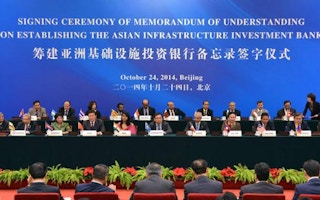After a late flurry of additions to the founding membership of the Asian Infrastructure Investment Bank, attention now turns to setting the China-led AIIB’s rules and regulations. But important questions remain – most important, whether the AIIB is a potential rival or a welcome complement to existing multilateral financial institutions like the World Bank.
To continue reading, subscribe to Eco‑Business.
There's something for everyone. We offer a range of subscription plans.
- Access our stories and receive our Insights Weekly newsletter with the free EB Member plan.
- Unlock unlimited access to our content and archive with EB Circle.
- Publish your content with EB Premium.
Since China and 20 mostly Asian countries signed the AIIB’s initial memorandum of understanding last October, 36 other countries – including Australia, Brazil, Egypt, Finland, France, Germany, Indonesia, Iran, Israel, Italy, Norway, Russia, Saudi Arabia, South Africa, South Korea, Sweden, Switzerland, Turkey, and the United Kingdom – have joined as founding members.
According to China’s finance ministry, the AIIB’s founding members are to complete negotiations on the Articles of Agreement before July, with operations to begin by the end of the year. China will serve as the standing chairman of the negotiators’ meetings, which will be co-chaired by the member country hosting the talks. The fourth chief negotiators’ meeting was completed in Beijing in late April, and the fifth will take place in Singapore in late May. The Chinese economist Jin Liqun has been selected to lead the AIIB’s Multilateral Interim Secretariat, charged with overseeing the bank’s establishment.
While GDP will be the basic criterion for share allocation among the founding members, the finance ministry suggested in October that China does not necessarily need the 50 per cent stake that its GDP would imply. Moreover, although the AIIB will be based in Beijing, the ministry has said that regional offices and senior management appointments will be subject to further consultation and negotiation.
Like the $50 billion New Development Bank announced by the BRICS countries (Brazil, Russia, India, China, and South Africa) last summer, the AIIB has faced considerable scrutiny, with some Western leaders questioning its governance, transparency, and motives. Indeed, many in the West have portrayed their establishment as part of an effort to displace existing multilateral lenders.
But the new development banks seem less interested in supplanting current institutions than in improving upon them – an objective shared by those institutions themselves. As Deputy Finance Minister Shi Yaobin pointed out recently, by recognizing the need to reform their governance, existing multilateral lenders have shown that there are, in fact, no “best practices” – only “better practices.” There is no reason improvements cannot originate elsewhere.
In fact, given its experimental approach to development, China is well-suited – and, as some top officials have hinted, more than willing – to contribute to this process. If China can help find a way to balance the need for high standards and safeguards in project lending with the imperative of rapid loan dispersion, global economic governance would benefit significantly.
“
One can see the emerging contours of a South-South development-finance landscape – one with the potential to transform multilateral lending more broadly.
In pioneering a more pragmatic approach to development finance, China’s institutional model could be the $40 billion Silk Road Fund that President Xi Jinping announced last November. The SRF and the AIIB will serve as the key financial instruments of China’s “One Belt, One Road” strategy, centered on the creation of two modern-day Silk Roads – the (overland) “Silk Road Economic Belt” and the “Twenty-First Century Maritime Silk Road” – stretching across Asia toward Europe. The initiative will aim to promote economic cooperation and integration in the Asia-Pacific region, mainly by providing financing for infrastructure like roads, railways, airports, seaports, and power plants.
Yet the SRF has received scant attention from Western media. This is unfortunate, because what little is known about it suggests that it could play an important role in transforming development finance.
According to Chinese media, the SRF will be capitalized by four state agencies. The State Administration of Foreign Exchange will hold a 65 per cent stake; the China Investment Corporation (CIC, the country’s sovereign-wealth fund) and the China Export-Import Bank (China Exim) will each have a 15 per cent stake; and the China Development Bank (CDB) will hold the remaining 5 per cent. The Fund was officially registered in December 2014, and held its first Board of Directors meeting the following month.
In a sense, the SRF can be considered China’s latest sovereign-wealth-fund initiative, and some media have even referred to it as the “second CIC.” But, whereas the CIC is under the managerial control of the finance ministry, the SRF’s operations appear to reflect the influence of the People’s Bank of China.
In a recent interview, the PBOC’s governor, Zhou Xiaochuan, suggested that the SRF would concentrate more on “cooperation projects,” particularly direct equity investment, before hinting at the Fund’s “just right” financing features. For example, Zhou indicated that the SRF will adopt at least a 15-year time horizon for investments, rather than the 7-10-year horizon adopted by many private equity firms, to account for the slower return on infrastructure investment in developing countries.
Moreover, the SRF could act as a catalyst for other state financial institutions to contribute to a selected project’s equity and debt financing. The Fund and other private and public investors – would first make joint equity investments in the project. China Exim and the CDB could subsequently disburse loans for debt financing, with the CIC providing further equity financing. When the AIIB is up and running, it, too, could support this process, by arranging debt financing alongside SRF’s initial equity investment.
Of course, there is still much to digest in these new financing initiatives. But one can see the emerging contours of a South-South development-finance landscape – one with the potential to transform multilateral lending more broadly.
Richard Kozul-Wright, Director of the Division on Globalization and Development Strategies at the United Nations Conference on Trade and Development, is the author, most recently, of Transforming Economies: Making Industrial Policy Work for Growth, Jobs and Development (co-authored with the International Labour Office). Daniel Poon is an Economic Affairs Officer at the United Nations Conference on Trade and Development.
Copyright: Project Syndicate, 2015.
www.project-syndicate.org











